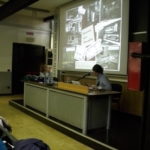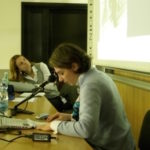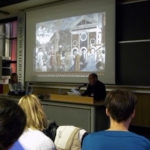Skip to content
Teaching
2023___ Accademia di Brera-Design, Milano.
2021___ ISIA Design, Firenze.
2022___ ISIA Design, Roma-Pordenone.
2019 ___ Politecnico di Milano, Scuola del Design.
2015 ___ Master in Exhibition Design-Architettura dell’Esporre, POLI.Design, Milano.
2019___ Politecnico di Milano, Scuola di Architettura Urbanistica Ingegneria delle Costruzioni.
2020-2023 IED (Istituto Europeo di Design), Firenze.
2020-2021 Università Ca’ Foscari, Venezia.
2019-2022 Université Jean Monnet, Saint-Etienne.
2017-2018 IECA-Université de Lorraine, Nancy.
2016-2017 Esdac, Aix-en-Provence.
ConferenceS
> 2023 30-01 November/December Design et artisanat. Anni Albers et la recherche d’un design lent, Colloque Les matrices disciplinaires du design, Université Toulouse Jean-Jaurès, Maison de la Recherche, Laboratoire Lara-Seppia.
> 2023 29-01 September/October Intelligenza artificiale. Trasformazioni e implicazioni nella didattica: prospettive per l’insegnamento di Storia e Cultura del Design, Convegno annuale dell’ANDA-Associazione Docenti Afam, Conservatorio Statale di Musica Orazio Vecchi-Antonio Tonelli, Modena, https://www.anda-afam.it/modena/
> 2022 6-9 July Time trajectories and associations in house-museums maintenance: a situated understanding, with Gianluigi Viscusi (Imperial College London), Conference EASST 2022 -The politics of technoscientific futures, Madrid, https://easst2022.org/
> 2022 17 May Le corps dans la ville. Les configurations urbaines de l’artiste Ugo La Pietra, journée d’étude La performance et la ville : architecture, organicité, mobilité, Université Gustave Eiffel, Paris.
> 2022 9-10 May Méthodologies de design. Giancarlo de Carlo, pratiques et implications de la participation, 3e Colloque Intersections du design, Le design dans la démocratie, en partenariat avec la revue Sciences du Design, le groupe de recherche Design, innovations et humanismes, le groupe de recherche Design et société, la Chaire de recherche Concordia Integrated Design, Ecology And Sustainability for the Built Environment (IDEAS-BE), la Chaire de recherche UQAM en design pour la cybersanté mentale (DIAMENT) et le Ohio State Desis Lab.
> 2022 24-25 March Autoprogettazione, une façon de penser le design, colloque Vers une généalogie de la notion de design: pour une lecture critique de l’idée de fonction, HAR UR 4414 Univ. Paris Nanterre, Institut Universitaire de France (IUF), Centre de recherche en design ENSCI Les Ateliers-ENS Paris-Saclay.
> 2022 01 February Webinaire de lancement de la revue Exercice(s) d’Architecture #10, dossier La ville n’est jamais achevée, ENSAB_Ecole Nationale Supérieure d’Archicture de Bretagne.
> 2021 15 November Webinaire, Workshop Ancrage-Thème “Art, culture et territoire”, L’objet artisanal comme ressource territoriale. Les collections d’Ugo La Pietra, CoDoc ART-Dev, UMR 5281, UniversitéPaulValéryMontpellier3.
> 2021 24-25 September Pratiche di allestimento. Il display come dispositivo di messa in scena della fotografia, convegno Paradigmi del fotografico. Teorie e poetiche in dialogo con le arti visive, Università di Bologna, DAR-Dipartimento delle arti, in collaborazione con DAMSLab | La Soffitta | CFC Culture Fashion Communication – International Research Center | Fondazione MAST.
> 2021 28 April Configurer l’environnement : entrelacement entre fiction et architecture, Vidéos-Conférences, vidéo table-ronde publique, #1 Archifictions-Anticipation Archifictionnelles, Université de Strasbourg,
> 2021 28 January Comment les designers écrivent-ils? Pratiques d’écriture, pratiques de critique. Le discours critique en Art et en Design – Pratiques et enjeux contemporains, Table ronde avec Romain Mathieu, Chiara Rubessi, Elsa Vettier et Kader Mokaddem, ESADSE, Saint-Etienne, Cité du design
> 2020 28-29 September Visualisation de données et espace d’exposition : enjeux et pratiques, 7e conférence Document numérique et Société. Humains et données : création, médiation, décision, narration, Université de Lorraine, Nancy.
> 2029 11-14 September Schermo e immagine in movimento nello spazio urbano. Per una ridefinizione dell’esperienza spettatoriale, La città globale. La condizione urbana come fenomeno pervasivo, IX CONGRESSO AISU STORIA URBANA, Bologna.
> 2019 13-15 June Co-concepteur, co-organisatrice et co-realisatrice, modératrice, Colloque international Dea_Design d’espace/Allestimento, Paris 2019, Paris 8-Ensa Paris-Malaquais. DEA_PROCEEDINGS_pdf
> 2019 4-5 April L’espace de la femme dans la société italienne: la dimension parentélaire dans le cinéma de Marco Bellocchio, Femmes engagées au coeur de l’action. Espace euro-méditerranéen. Mise en récit(s), mise en image(s), Université de Lille 3, Université de Lorraine, Nancy.
> 2018 20-22 June La mise en scène des artefacts. L’exposition temporaire Il nilo a pompei, Des lieux pour penser musées, bibliothèques, théâtres, Université Sorbonne Nouvelle Paris 3, ICOFOM.
> 2017 24 November Un dispositif de reconnaissance pour les designers: le phénomène carte blanche au designer, stratégies e dispositifs de reconnaissance dans le champ du design et des arts décoratifs, Université Saint-Étienne.
> 2017 29 June Reinventing landscape: questioning the intertwining between cinema and architecture, Sensibility and the senses-media. bodies, practices, NECS PARIS 2017, Université Sorbonne Nouvelle Paris 3.
>2017 25-26 January Il paesaggio-specchio nell’organizzazione dello spazio in Deep End di Jerzy Skolimowski, Convegno Internazionale Cinema e paesaggio. Filmare le arti, Università di Firenze.
> 2016 5-7 September Un dispositif d’art-spectacle: autour de l’exposition Edward Hopper, Rome 2010, Colloque International Les dispositifs de simulation du monde du XIXe siècle à aujourd’hui. Inventer, expérimenter et transformer le réel, Université de Genève.
> 2015 23-24 June La famille exposée : pratiques du cinéma amateur en Italie , Colloque International L’amateur en cinéma, un autre paradigme?, Université François Rabelais, Tours.
> 2014 24 November Cabiria, ou la mise en scène de la masse, Journée d’étude, Traverses 19-21, Université Stendhal-Grenoble 3.
> 2013 17 June Une vie suspendue. Il Rifugio de Francesco Cannito et Luca Cusani (2012) comme espace de la limite et de l’exception. GRHED (Groupe de recherches en histoire et esthétique du cinéma documentaire) Université Paris 1 – CERHEC.
> 2013 12 April Scénographie et esthétique: étude sur la conception de l’espace cinématographique, Journée doctorale, Laboratoire Traverses 19-21, Université Stendhal-Grenoble 3.
> 2012 14 May GRHED (Groupe de recherches en histoire et esthétique du cinéma documentaire) Université Paris 1–CERHEC. Séance dirigée par C. Rubessi en présence du réalisateur Hugues Le Paige : Ethnographie et construction sociale du réel dans Il fare politica. Chronique de la Toscane rouge (1982-2004) de Hugues Le Paige.
> 2012 2-4 April Fitzcarraldo de Werner Herzog. Le bateau comme rêve et folie, Journées d’études doctorales Un autre regard sur l’objet, Laboratoire langages, littératures, sociétés, Université de Savoie-Chambéry.
> 2012 8-9 March Voyage dans la politique italienne. Il fare politica. Chronique de la Toscane rouge (1982-2004) de Hugues Le Paige , Université Stendhal Grenoble 3-Université Lyon 2.
> 2010 5-6 October Modératrice de séance Conférence International IFW-Interiors Wor(l)ds, Politecnico di Milano.



QUALIFICATION
> 2022 Qualification aux fonctions de Maître de conférences, CNU 18 section (Architecture (ses théories et ses pratiques), arts appliqués, arts plastiques, arts du spectacle, épistémologie des enseignements artistiques, esthétique, musicologie, musique, sciences de l’art, Conseil national des universités, France.
> 2019-2023 Qualification aux fonctions de Maître de conférences des Écoles nationales supérieures d’architecture, Ministère de la culture, France.
> 2017-2021 Qualification aux fonctions de Maître de conférences, CNU 18 section (Architecture (ses théories et ses pratiques), arts appliqués, arts plastiques, arts du spectacle, épistémologie des enseignements artistiques, esthétique, musicologie, musique, sciences de l’art, Conseil national des universités, France.
Grants
> 2022 November Visiting Scholar, Master DYCLAM+ Erasmus Mundus, Faculté de Sciences Humaines et Sociales, Université Jean Monnet, Saint-Etienne. Supervisor: Prof. Robert Belot. Subject: Expographie et Patrimoine. Savoir, narration et médiation.
> 2015 January-February Borsa di studio, Scuola Dottorale dell’Università Grenoble Alpes. Visiting Student presso il MUDAC (Musée de design et d’arts appliqués contemporains) di Losanna. Progetto di ricerca d’archivi0 volta allo svolgimento di uno studio sull’allestimento delle mostre di design del museo.
> 2013 February-May Borsa di studio, Scuola Dottorale dell’Università Grenoble Alpes. Visiting Student presso l’Unil di Losanna. Partecipazione a un atelier interdisciplinare dal titolo Vision synthétique du monde: cinéma, photographie, globalisation.
Jury (board of examiners)
> 2014 June DNSEP Design Espace. President of the jury Ensba (École nationale supérieure des beaux-arts), Lyon. Jury Présidente : Mme Chiara RUBESSI [Designer] Personnalité qualifiée : Mr David DES MOUTIS [Designer] Personnalité qualifiée : Mme Agnès MARTEL [Designer] Personnalité qualifiée : Mr Thomas GOLSENNE [Historien d’art] Représentant de l’École : Mr Olivier VADROT.
Translate »


